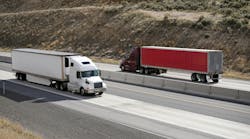The most important thing to understand about storing or not using tires for long periods is that they're engineered chemical composites and rely on flexing under load to protect themselves from other environmental chemicals. Loaded tires are also mechanically stressed in the deflected footprint area of the tire/road surface interface. Lower inflations result in greater deflection, or more stress.
Understanding these basics will help explain the following recommendations on storing unused tires:
Keep tires dry
Normal rainfall won't hurt tires if they're mounted and moisture isn't allowed to accumulate inside the casing. But water should never sit inside tires. Any tires with cuts, stone drills, punctures, or other damage should be repaired prior to storage to avoid moisture migration into the casing. If tires are removed from vehicles for storage, it's a good idea to place them on a wooden platform to protect from wet floors or any other form of frequent dampness. Tires stored on vehicles should not sit in standing water.
Avoid contact with petroleum products
Oils, grease, fuels, and solvents are readily absorbed by some rubber compounds and can deteriorate the physical properties of tires. Oily floors, misplaced grease rags, leaking wheel seals, and minor fuel spills can all cause problems.
Minimize exposure to heat and light
Modern tires are designed to perform well with normal exposure to heat and light sources. However, if allowed to sit in one position for long time periods, heat and/or light can be concentrated on specific portions of a tire and cause premature oxidation of the tire surface. Severity of this condition is time and temperature dependent, and while minor surface cracking usually presents no problems, excessive exposure can result in an unusable casing. Direct sunlight and high heat sources should be avoided to the extent possible. Parking stored trucks close together facing East or West is a good practice. If tires can be covered, use an opaque or black polyethylene film.
Don't overclean
Most manufacturers advise against excessive cleaning of tires to be stored, regardless of whether or not they are mounted. Dirt alone is not harmful to tires, and frequent washing, especially using aggressive cleaning agents, can interfere with the migration of protective chemicals in the compounds.
Minimize ozone exposure
Ozone occurs naturally in the atmosphere and some exposure is inevitable. However, tire and vehicle storage areas should be selected to avoid heavy concentrations such as found near electric motors, welding equipment, some power lines and switches since it can cause premature cracking in tires over extended time or in heavy doses.
Enforce FIFO inventory
Normal aging is detrimental to most chemical composites, including tires, over time. Therefore, it makes good business sense to practice first-in/first-out (FIFO) inventory.
One other frequently asked question relates to recommended inflation for tires stored mounted on vehicles. If all loading is removed from the tires, lowering inflation pressure to a minimum of about 15 psi should be beneficial. The more common recommended practice is to increase inflation to 25% beyond that required for the actual load being applied to the tire in storage, provided that value doesn't exceed the maximum pressure approved by the tire maker. This reduces deflection and stress concentrations in the footprint area. Naturally, inflation adjustments and overall tire inspections are necessary before you return the tire to service.


